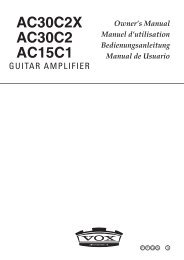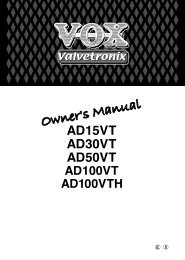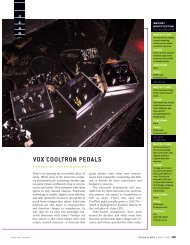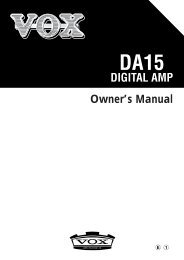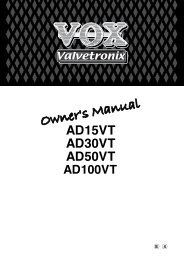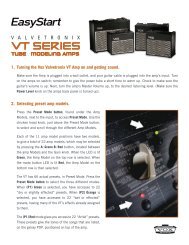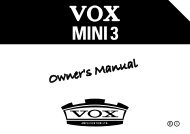VOX AC50/100CP Owner's manual - The VOX Showroom
VOX AC50/100CP Owner's manual - The VOX Showroom
VOX AC50/100CP Owner's manual - The VOX Showroom
- No tags were found...
You also want an ePaper? Increase the reach of your titles
YUMPU automatically turns print PDFs into web optimized ePapers that Google loves.
CHANNEL 1 SECTION3. GAIN CONTROLThis control regulates the amount of signal amplification that is generated in the Channel 1preamplifier circuit, and as such sets the basic tonal qualities of the channel. <strong>The</strong> circuit design ofChannel 1 is based on the Top Boost channel of the historic <strong>VOX</strong> AC30. <strong>The</strong>refore the basicsound of this channel is classic <strong>VOX</strong> through and through. But by some subtle changes andtweaks this channel will also give you some serious classic rock Crunch. Although different typesof guitars and pick-ups will give differing output levels and thus amp settings will vary betweendifferent guitars, then generally the rule of thumb is that cleaner sounds are going to be betweenOff (naturally!) and about 2 o’clock position of the knob. After that the channel preamp will slowlystart to go into crunchy distortion, with the maximum distortion at Full (of course!). Although thischannel is not seriously high gain (we’ve left that for channel 2) the distortion level can be seriouslysatisfying.4. EQ and TONE controls<strong>The</strong> TREBLE, MIDDLE, and BASS controls on this channel are of the interactive passive formatthat is historic to <strong>VOX</strong> amplifiers. This type of EQ is sometimes nicknamed as the “tone stack” bythe nature that the three controls are drawn on a circuit diagram. Generally speaking, the positionof each control knob will influence the effect of the other two. Our advice is to set the threecontrols at their midpoint positions and start from there. Experimentation is the key to finding yourtone. For starters though, turning the Middle control down will make the sound more “hollow”particularly with high gain (distorted) settings, as typified on many modern heavy rock songs.Turning the Middle up will make the tone fuller, smoother and produce a more “singing” tone.Adjust Bass & Treble to suit.<strong>The</strong> TONE CUT control is a classic <strong>VOX</strong> control that dates back to the very first <strong>VOX</strong> amplifier of50 years ago, when it was the only form of tone control on the amplifier. In keeping with its name,this control works by reducing (CUTS) the amount of high frequency content of the sound andthus smoothes out and warms up the treble. When using this control please remember that asyou turn the control UP that you are actually turning DOWN the Treble.5. REVERBThis control regulates the amount of the on-board spring reverberation required for Channel 1only. Please remember that the reverb is controlled ON or OFF by the footswitch as well.6. VOLUMEThis control is set at the end of the Channel 1 preamp circuit, before it goes to the FX Loop,Reverb, and Power Amp sections. As such it governs how loud the sound generated by theChannel 1 electronics is going to be. Low settings of the control will mean the amp will be prettyquiet, and higher settings will mean total mayhem has broken out! As the total sound level iscontrolled by both the Gain and Volume controls (and the Output Master, but more on this later)you will need to balance both the level and character of the sound with both these controls.CHANNEL 2 SECTION7. GAIN CONTROLThis control regulates the amount of signal amplification that is generated in the Channel 2preamplifier circuit. <strong>The</strong> circuit design of Channel 2 is out and out mean, meaty and mighty – butwith a good measure of <strong>VOX</strong> thrown in as well! <strong>The</strong> basic sound of this channel takes off whereChannel 1 finishes; and by use of all of this channel’s controls you can achieve a variety ofsounds from gentle blues to classic rock to modern high gain wailing.6



